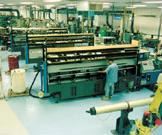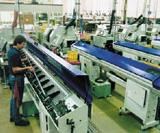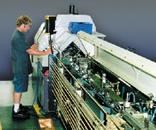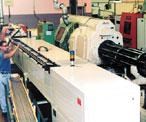Choosing The Right Bar Feeder
Take a look at some of the options, and find out how some shops make their decisions.
Share





Why does a company select one type of bar feeder over another for a turning machine? Perhaps the company is simply content to follow the recommendation of the distributor who sold it the lathe. Or it may own a battery of bar machines equipped with a certain type of bar feeder and just be following suit. Or the company may make the decision only after a thorough analysis of bar-loading time, setup time and other factors that affect productivity.
The best bar feeder is the one that best meets the needs of the user for his or her particular circumstances, and those circumstances are probably as varied as the number of shops that specialize in turning. To prove the point, we have assembled several examples of shops that operate bar feeders. For the purpose of covering the major types of bar feeders, we focused tightly on a particular type of bar feeder at each shop instead of trying to catalog all of the shop's bar feeders or to go into detail about the principal operations of the shop.
You may have purchased a new CNC single-spindle lathe, screw machine or some other bar machine recently, or perhaps you are looking to make your next bar machine acquisition. It is hoped that some of the considerations this article raises about bar feeder selection will answer some of your questions and help you to choose the best bar feeder for that new machine.
Starting With The Basics
Camcraft (Hanover Park, Illinois) is a manufacturer of precision turned parts that operates a large number of production CNC single-spindle lathes, including a battery of a dozen or so Index sliding-headstock machines. Most of them are equipped with modern, magazine-type, 12-foot-capacity bar feeders—a type of bar feeder that we will cover later.
However, several of Camcraft's CNC lathes are equipped with Hydrobar six-tube, hydrodynamic bar feeders, made by LNS America, Inc. (Cincinnati, Ohio). This type of bar feeder has three or six tubes, each of which can accommodate a different bar size (diameter) range. The tubes revolve in a drum about a center axis, like bullet chambers in a revolver, and the lathe operator rotates the drum to align the appropriate tube for the bar diameter being used with the lathe spindle. The tube can only hold one 12-foot bar, and when the bar is consumed, the operator must pivot the bar feeder away from the spindle, load a fresh bar into the tube from the front, reposition the bar feeder at the spindle and restart the lathe.
The hydrodynamic bar feeders, with their cannon-like appearance, seem out of place given the rectangular look of the shop's other bar feeders. But appearances can be deceiving and, in fact, the hydrodynamic bar feeders are considered more efficient for the jobs they are being used for than any other type of bar feeder in the shop.
"Most of our CNC lathes are production machines running rather large quantities of parts, and we equip those machines with magazine-type, 12-foot-capacity bar feeders to ensure that there are never any production interruptions because of stock outages," explains Marc Bossert, engineering manager for Camcraft. "However, we use some CNC lathes primarily for jobs consisting of relatively small quantities of parts with fairly long cycle times, and those lathes are equipped with hydrodynamic bar feeders. One bar may last for 1 or 2 hours, and the job may require only two or three bars. It takes only one or two minutes to load a fresh bar, so the brief interval that the lathe stands idle while a fresh bar is loaded into the bar feeder does not have much of an impact on the efficiency of the operation."
Adding to its suitability for short-run operation, the hydrodynamic bar feeder changes over for the next job relatively quickly. "You simply decide which of the six tubes most closely matches the bar size to be run, rotate the drum to that tube, insert an appropriately sized liner in the lathe spindle, load the first bar, feed it into the spindle, and you're ready to run," Mr. Bossert explains. "That's about as quick as it gets. Setup time on the magazine-style bar feeder can be considerably longer: there are more adjustments to make, more settings to change."
Short On Space?
Most shops would rather run 12-foot bars than shorter bar lengths: the yield is better, and less running time is lost to bar changing. But what happens when a shop just cannot find the space for a bar feeder capable of handling 12-foot bars? Answer: It buys a spindle-length bar feeder. That was the situation with Bryco Machine (Tinley Park, Illinois), a precision turning shop. Bryon Bettinardi, Bryco's president, started his business 18 years ago in a small, 5,000-square-foot shop. As the business grew, he added several Mori Seiki CNC bar machines, but the tight quarters did not give him much room to install 12-foot-capacity bar feeders. Mr. Bettinardi solved his space availability problem by equipping his CNC bar machines with Quick Load spindle-length bar feeders made by LNS America.
The spindle-length bar feeder is a magazine-type unit that accepts multiple 4-foot bars and automatically feeds them, one after another, into the CNC lathe. Operation of the spindle-length bar feeder is completely automatic. Once the operator loads a number of bars onto the inclined tray at the side of the unit, he or she is free to perform other tasks, such as loading other bar feeders, running a secondary op machine, doing part inspection and so forth.
The spindle-length bar feeder also solves a problem common with standard-length (12-foot-capacity) bar feeders. Shops want to run their bar machines as fast as possible to achieve high production rates. However, as the rotating speed of a 12-foot bar increases, the bar tends to whip and vibrate, which adversely affects machining results. "The problem is probably more with the material (bars) than with the bar feeder," Bryco's Mr. Bettinardi explains. "Even though we have our bars centerless ground and straightened, when you're trying to run at 10,000 rpm with a 12-foot bar, the slightest bend will cause a lot of whipping. To ensure that we produce defect-free parts, we must reduce the vibration, and to do that we must slow down our machines.
"However, by feeding the bars in 4-foot lengths on the compact bar feeder, we are able to reduce the vibration problem, which enables us to run at higher rpm," Mr. Bettinardi explains. He points to still another advantage of the spindle-length bar feeder: "Changeovers on our 12-foot-capacity, magazine-type bar feeders can often be lengthy," he explains. "But we can frequently change over the spindle-length bar feeder on the fly so that the bar machine keeps running."
Another important feature of the spindle-length bar feeder is its ability to handle large-diameter bars—bars that no other bar feeder can accommodate. Pacific Bearing Co. (Rockford, Illinois) makes the Simplicity line of self-lubricating linear bearings. Many of the components for the firm's bearings are blanked on a trio of CNC lathes served by magazine-type, 12-foot-capacity bar feeders. However, the firm has another CNC lathe, used for turning larger parts, and that lathe is served by an LNS America Quick Load spindle-length bar feeder.
"We use the CNC lathe with the spindle-length bar feeder to handle all of our turning requirements over 2 inches," explains Chris Mabie, engineer for Pacific Bearing. "We are very concerned about part cycle times on our bearing component blanking lines, but we usually produce much smaller part quantities on our larger lathe, thus cycle times aren't all that critical. For the number of large parts that we produce, the spindle-length bar feeder meets our throughput requirements just fine.
"The spindle-length bar feeder also gives us an alternative to feeding long lengths of large-diameter bar," Mr. Mabie continues. "When we get a lot of vibration, we have to slow the lathe's spindle speed, slow all of the tools down...we lose cycle time. But running the job on the larger CNC lathe with the spindle-length bar feeder, the whole 4-foot bar is contained in the lathe spindle, and we can really crank up the spindle speed."
Twelve-Foot Magazine Types
The magazine-type, 12-foot-capacity bar feeder puts it all together: fast cycle times, efficient bar utilization, low labor cost (one operator can load several machines), and ability to run unattended for long intervals. Where circumstances permit its use, it is the bar feeder of choice for CNC lathes for the shops we visited. Even though initial purchase price of these bar feeders is relatively high, users had no trouble justifying their purchases.
We described Camcraft's use of hydrodynamic bar feeders for small-lot jobs earlier, however most of the shop's CNC production lathes are equipped with magazine-type 12-foot-capacity bar feeders, made by IEMCA (St. Louis, Missouri). "Our Citizen (and other) CNC lathes are fast production machines representing a sizeable investment," Camcraft's Mr. Bossert stresses. "We can't afford to have those machines standing idle waiting for stock. When the lathe has used up one bar, the magazine-type, 12-foot-capacity bar feeder automatically loads the next one so that machining continues almost without pause. There is no waiting for an operator to notice that the machine is out of stock. The continuous operation translates to more parts at the end of the day.
"Because the operator loads a dozen or more bars at a time in the magazine-style bar feeder, he can tend several machines at once and still have time for other chores," Mr. Bossert continues. "In fact, the automatic operation of the bar feeder lends itself to unattended operation during breaks, at night, holidays, even weekends if we choose."
Pacific Bearing's Chris Mabie echoes Mr. Bossert's sentiments. The firm has three production CNC lathes to turn components for its linear bearing line. Each lathe is dedicated to a limited size range (1 inch to 3/4 inch, 1 5/8 inches to 1 inch, and 2 inches to 1 5/8 inches) to minimize the number of changeovers required for different part runs—and each is served by a Cyclone 12-foot-capacity, magazine-type bar feeder made by Alpine Automation Inc. (Orem, Utah).
"One operator can maintain all three machines," Mr. Mabie explains. "Once the machine is set up and the bar feeder loaded with, say, ten or 15 bars of 1-inch bar, a machine will run for 4 to 5 hours without intervention.
"We are totally focused on holding down cycle times and running unattended where possible to reduce costs, and the magazine-style bar feeders help us to achieve both these goals," Mr. Mabie continues. "The continuous automatic bar loading provides totally predictable production times, which makes it easier for us to meet our production schedules.
"With the magazine-style bar feeder, you can calculate precisely how long it will take to run a job," Mr. Mabie adds. "Simply multiply the cycle time per part times the number of parts per bar times the number of bars required for the job, add 15 to 25 seconds loading time per bar, and you know what time the job will end. When we ran unattended over weekends in the past, it was my responsibility to come in to restock the bar feeders. The running time for the jobs was so predictable that I would come in Saturday night just in time to find the last bar in the machine and the pusher just about ready to go back and get the next one."
In addition to its automatic bar-loading capability, the 12-foot capacity, magazine-type bar feeder solves quality control and housekeeping problems that have plagued shops with manually loaded bar feeders for decades. On manually loaded bar feeders, a fresh bar can be loaded so forcefully that instead of coming to rest against the stock stop in the lathe, it strikes it and bounces back a bit. The result can be a short part, which makes customers unhappy. The magazine-style bar feeder improves on the old method by monitoring the actual location of the bar to make sure its end is positioned in the right spot.
Then there is the matter of bar remnants. Bar machines use all of the bar except for a short remnant that must be removed before the next bar is loaded, otherwise the remnant can get mixed in with the good parts and counted as a defective part. The magazine-style bar feeder automatically retrieves the remnant, carrying it to the rear and dropping it into a pan to prevent its being included with the good parts.
One of the magazine-style bar feeder's biggest pluses is its impact on material utilization. When 12-foot bars are loaded into a standard length bar feeder, the entire bar except for a small remnant is used. But cut that bar into 4-foot lengths for use on spindle-length bar feeders, and you increase the number of remnants and reduce the yield of piece parts.
How important is that? Bryco Machine produces small-diameter, precision parts on 13 Citizen CNC sliding-headstock lathes that are served by LNS magazine-type, 12-foot-capacity bar feeders. Bryco president Mr. Bettinardi is seeing more competition from firms that have added sliding-headstock machines, with resultant downward pressure on prices. "We need to optimize our material utilization to remain competitive, and our magazine-type 12-foot-capacity bar feeders are helping us do the job," Mr. Bettinardi says.
For Multi-Spindles Too
Up to this point, we have discussed bar feeders for single-spindle CNC lathes, but there are bar feeders that make multi-spindle lathes more efficient as well. Amtec Precision Products, Inc. (Elgin, Illinois) is a world-class producer of precision turned parts for the automotive, hydraulics, appliance, defense and other industries. The firm prides itself in being the sole supplier to "virtually all" of its customers. It designs a manufacturing process for every job, bringing to bear a large and impressive array of precision turning equipment.
Amtec's turning machines include approximately 90 Gildemeister multi-spindle bar machines with capacities ranging from 0.375 inch to 4 inches. (The firm's equipment list identifies more than 300 primary machine tools in addition to numerous secondary machines.)
Many of the firm's multi-spindle bar machines have conventional stock reels with bar tubes that must be loaded manually. Andrew Hain, executive vice president for Amtec, explains the problem with manual loading: "When one of our older Gildemeisters runs out of stock, it shuts itself off," he says. "The machine operator must go to the front of the machine, remove the bar end (remnant) and discard it, and then go to the back of the machine and load a fresh bar into the stock tube. Loading the fresh bar is no easy task: he must guide it through the bar tube's compression springs and literally pound it through the bar feeder collet to the stock stop. In the process, he will sometimes peen over the end of the bar, making it difficult to remove.
"It takes the operator 6 to 8 minutes to load fresh bars into the stock tubes," Mr. Hain continues. "The machine remains idle while the operator does this, and he may need to reload the machine 12 to 14 times per day. That's well over an hour of production time lost per day per machine.
"We wanted to automate the bar-loading operation to eliminate that lost production time," Mr. Hain continues. "One option was to buy a magazine-style bar loader that attached to the back of the multi-spindle machine and loaded bars into the existing stock tubes. The problem with that solution is that it increased the length of the machine by about 15 feet. Given the large number of machines involved, plant space limitations precluded that option. The solution to our problem turned out to be a magazine-type bar loader, made by Pietro Cucchi America Inc. (Elk Grove Village, Illinois), which replaces the stock reel of the multi-spindle machine. The bar loader attaches directly to the back of the machine, making for a compact arrangement."
The multi-spindle-machine bar loader has most of the features of the magazine-style bar feeder for single-spindle lathes described earlier. The operator can load 20 to 30 bars into the bar feeder, and the unit will load the multi-spindle machine automatically. Instead of pounding bars into stock tubes, the operator is now free to load other machines, check critical dimensions on parts, or attend to other assignments. The bar loader automatically extracts bar ends, and a monitoring system accurately positions the bar for machining, eliminating the familiar short-part problem.
According to Mr. Hain, the multi-spindle bar loader provides an additional 90 minutes of uptime per machine per day. He adds that when a new multi-spindle machine is purchased, it will be purchased without a stock reel and will be installed with a magazine-style bar loader.
Which is the best type of bar feeder? As we mentioned at the onset, it's the one that best meets the user's set of circumstances. No one bar feeder is best for every application, as borne out by the fact that all of the shops that we visited use several types.
If you are thinking about buying a new bar machine and wondering what kind of bar feeder it should have, this article hasn't made your decision as easy as, say, filling out a checklist. However, you should be able to identify with some of the needs our shops addressed in making their buying decisions, and it is hoped that will help you make yours.
Related Content
Lean Approach to Automated Machine Tending Delivers Quicker Paths to Success
Almost any shop can automate at least some of its production, even in low-volume, high-mix applications. The key to getting started is finding the simplest solutions that fit your requirements. It helps to work with an automation partner that understands your needs.
Read MoreUsing Automation to Reduce COGS and Stay Globally Competitive
Decade-long, multiphase automation investments lower operating costs and maintain technology lead in an increasingly competitive global market.
Read MoreNavigating Large-Scale CNC Machining: Suburban Tool’s Niche Strategy to Stay Competitive
Facing increasing competition from lower-cost imports, Suburban Tool made a move toward large-scale, in-house machining. By identifying a niche in large, precision angle plates and tombstones, the company has strengthened its ability to control quality and protect its reputation.
Read MoreShop Doubles Sales with High-Mix, Low-Volume Automation
Robots with adaptive grippers have opened entire shifts of capacity to high-mix, low-volume shop Précinov, doubling its sales.
Read MoreRead Next
5 Rules of Thumb for Buying CNC Machine Tools
Use these tips to carefully plan your machine tool purchases and to avoid regretting your decision later.
Read MoreBuilding Out a Foundation for Student Machinists
Autodesk and Haas have teamed up to produce an introductory course for students that covers the basics of CAD, CAM and CNC while providing them with a portfolio part.
Read MoreSetting Up the Building Blocks for a Digital Factory
Woodward Inc. spent over a year developing an API to connect machines to its digital factory. Caron Engineering’s MiConnect has cut most of this process while also granting the shop greater access to machine information.
Read More



































